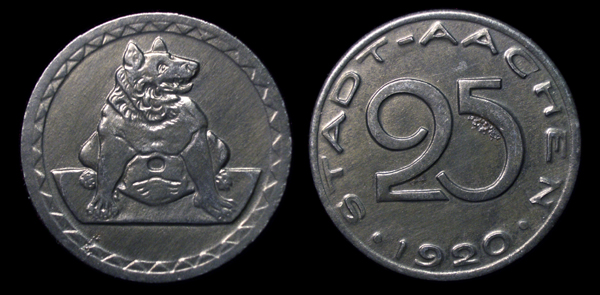
STADT AACHEN (GERMAN) 25 PFENNIG 1920
L- 1.6 City of Aachen (Rhineland) Iron 25 Pfennig Coin Depicting a Bear or a Wolf
This iron coin depicting a bear or a wolf was issued by the City of Aachen and was meant to be used as small change. It depicts what was often identified as a wolf statue that stands guard inside the entrance of the Aachen Cathedral. This, as well as other statues found in the cathedral, are thought to have been transfered there by Charlemagne to raise the stature of the city. Although the statue was thought to date back to the second century, more recent analyses suggest the eleventh century, and although at first the statue was thought to depict a wolf, more recent analysis suggests it is depicting a bear. The attribution of the statue as being a wolf may have contributed to the legend concerning the origin of the cathedral (see below).
 |
|
The Devil, the wolf and the Old Market Woman of Aachen: The people of Aachen were building a new cathedral but ran out of money. They tried everything to raise the funds but to no avail. The Devil came by and offered to help them on the condition that he receive the first soul to enter the new church. The people agreed as what is one soul compared to the many soul that would be saved by the new church? When the cathedral was completed, nobody would enter as they did not want to sacrifice their soul and be forever damned. The people of Aachen could not use their new church and the Devil was very satisfied by this. On the advice of a clever monk they captured a wolf and sent it into the cathedral robbing the devil of a human soul. Out of gratitude they put a statue of a wolf in the church. Furious with rage, the Devil fled the cathedral and slammed the door so violently that his thumb got stuck in the door and was torn off. The thumb is still there to this day. The Devil swore he would bury the whole town of Aachen so he went to the north sea of Germany and filled a bag large enough to bury the whole town with sand. On his way back to Aachen he became very weary from the weight of the bag and took a break, unknowingly just outside of the city. There he met an old woman and asked her how much further away was Aachen. The clever woman recognized him by his cloven foot and tail so she told him that she had come from the Aachen market, which was very far away. She pointed to the rock-hard bread she carried in a basket and to her worn shoes that were new when she left the market. When the Devil saw the shoes were worn and, believing the town was still far off, he threw away his bag as he could no longer carry the load. The sand poured from the bag making a hill at the spot where the Devils bag fell. This is why there is a statue of a wolf in the Cathedral of Aachen, why there is a large hill near Aachen, why the shoes produced in Aachen are so cheap! |
Aachen is a city located in the state of North Rhine-Westphalia in Germany. The westernmost city in the country, it sits along the borders of Germany, Belgium and the Netherlands. Evidence suggests the site was used as an ancient quarry until the Romans discovered the remote area and used it for its natural hot springs calling the area Aquis-Granum. Later it became home to the Emperor Charlemagne who often wintered there. He built a Palace Residence in the city as well as the Palatine Chapel around 800 A.D. King Otto I was Crowned at Aachen in 936 and until 1531, most German Kings who became Holy Roman Emperors were Crowned in Aachen at the collegiate church built by Charlemagne.
Like most cities with such a long history, its fortunes rose and fell many times and by the mid 17th century Aachen had become a popular destination for its hot springs that were said to have curative properties. There is ample evidence to show that it was also well known for prostitution. Aachen was a place one might go to try for a cure, but with syphilis and sex workers, one might come home sicker than before one made the trip.
Aachen was chosen as the site of several important congresses and peace treaties: The first congress of Aachen (the Congress of Aix-la-Chapelle) in 1668 and the First Treaty of Aachen in the same year ending the War of Devolution. A second congress and a second treaty in 1748, finishing the War of the Austrian Succession. A third congress took place in 1818 to decide the fate of occupied Napoleonic France. The city was a part of France under Napoleon's first French Empire, a part of Prussia after his defeat.
By 1840 the railway and modern industry had reached Aachen. The city and its 80,000 citizens suffered from overcrowding that caused serious drainage and sewage problems. Many were forced to live in deplorable conditions until city planning could expand and alleviate the problem. By 1930, Aachen had became an important industrial center well known for the production of locomotives and a thriving iron works among other industries.
Today Aachen is no longer such an important industrial center though it still hosts a variety of business concerns such as electronics, chemicals, plastics, textiles, and glass to name a few. It is also a popular destination for tourists interested in the city's rich history and its many historical sites.
